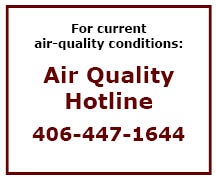Air Quality in the Helena Valley
The Environmental Health Division of Lewis and Clark Public Health monitors year-round the fine-particulate air pollution in the Air Pollution Control District.
It also enforces local outdoor air-quality(PDF, 498KB) regulations that were adopted to protect the health of area residents by controlling emissions of fine particulate pollution, also known as PM2.5
Fine-particulate air pollution includes soot, combustion byproducts, and liquid pollutants in the air.
Exposure to fine particulates can harm human health, especially among individuals with existing lung diseases. Studies have linked fine-particulate pollution to an increase in hospital admissions and emergency room visits.
To protect the health and well-being of all residents in Lewis and Clark County, our Prevention Team, in partnership with our Environmental Health Team, advocates for and educates the public on the importance of indoor air quality and clean rooms, especially during wildfire events and winter inversions. For information about how to protect yourself and your family, please visit our Indoor Air Quality page learn more about tips, tricks, and resources to make your home a sanctuary from air pollution and resulting health effects.
Indoor Air Quality
In addition, here are some helpful documents that will help you prepare for fire season and protect yourself and your family.
Prepare for Fire Season: Wildfire Smoke Factsheet(PDF, 205KB)
Wildfire Smoke Protective Measures(PDF, 178KB)
Current Air Quality Conditions
For real-time air quality updates, visit the LCPH Data Portal
You can also call the Air Quality Hotline at 406-447-1644.

On this page you will find resources about:
- Burning indoors and outdoors
- Air pollution from wildfires
- Health effects of poor air quality
Visibility Chart and Health Recommendations
Although the Helena Pollution Control District has live monitoring stations to determine air quality conditions, those conditions can change quickly. Published air-quality reports may not keep up with these changes. Sometimes visibility – how far you can see through the smoke – can be a better way to determine health hazards. See the chart below for a general reference on visibility and air quality.
| Air Quality Status |
Visibility |
Recommendation |
| Good |
13 miles or more |
Enjoy outdoor activities. No limitations. |
| Moderate |
9-13 miles |
May make existing heart or lung disease worse. |
| Unhealthy for Sensitive Groups |
5-9 miles |
Increased likelihood of breathing problems in sensitive people, including those with heart or lung disease, the elderly, and children. These individuals should limit strenuous activity outside. |
| Unhealthy for All Groups |
2-5 miles |
Increased breathing problems in the general population as well as in those with heart or lung disease. The elderly and people with heart or lung disease should avoid prolonged exertion outdoors. The general population should limit prolonged exertion outdoors. |
Very Unhealthy/
Hazardous |
Less than 2 miles |
Serious increase in breathing problems, even in healthy people. Premature death possible in the elderly and people with heart or lung disease. Sensitive people should stay indoors. Everyone should avoid all outdoor exertion. |